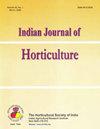Ground-cover management studies in kinnow orchard
Q4 Agricultural and Biological Sciences
引用次数: 0
Abstract
The six ground-cover species viz. aloe vera, brahmi, lemongrass, mentha, stevia and turmeric, were grownin the kinnow orchard. The cultivation of mentha, intercropped with kinnow, exhibited better performance interms of fruit length (5.81cm), fruit breadth (6.77 cm), fruit weight (156.50 g) and fruit yield (61.04 Kg), followedby brahmi as compared to other treatments. The quality attributes like juice content, total soluble solids (TSS),titratable acidity (TA), and TSS/TA of fruits grown under different intercropping systems were statistically at parwith control during the first year of study. However, the highest juice content (46.32 %), TSS (11.28 %), TSS/TA(14.25) and minimum TA (0.79 %) were recorded in kinnow intercropped with mentha. The highest leaf N contentwas recorded in the cover crops of Kinnow + mentha (1.97 %), P and K content in Kinnow + brahmi (0.20 and1.35 %, respectively), while these were found to be the lowest in control. Overall, Kinnow + mentha and Kinnow+ brahmi proved to be effective intercropping systems in the Kinnow growing areas金诺果园地面覆盖物管理研究
在金诺果园中种植了六种地被植物,即芦荟、婆婆纳、柠檬草、薄荷、甜叶菊和姜黄。与其他处理相比,在金诺果园间作种植薄荷,在果实长度(5.81 厘米)、果实宽度(6.77 厘米)、果实重量(156.50 克)和果实产量(61.04 公斤)方面表现较好,其次是婆婆纳。在研究的第一年,不同间作系统下种植的水果的果汁含量、总可溶性固形物(TSS)、可滴定酸度(TA)和 TSS/TA 等质量属性在统计上与对照组相当。然而,与薄荷间作的金诺果汁含量(46.32 %)、TSS(11.28 %)、TSS/TA(14.25)最高,TA(0.79 %)最低。金诺+薄荷覆盖作物的叶片氮含量最高(1.97 %),金诺+婆婆纳的叶片磷和钾含量最高(分别为 0.20 % 和 1.35 %),而对照组的叶片磷和钾含量最低。总之,在金翘种植区,金翘+薄荷和金翘+红豆被证明是有效的间作系统。
本文章由计算机程序翻译,如有差异,请以英文原文为准。
求助全文
约1分钟内获得全文
求助全文
来源期刊

Indian Journal of Horticulture
农林科学-园艺
CiteScore
0.50
自引率
0.00%
发文量
22
审稿时长
4-8 weeks
期刊介绍:
Information not localized
 求助内容:
求助内容: 应助结果提醒方式:
应助结果提醒方式:


